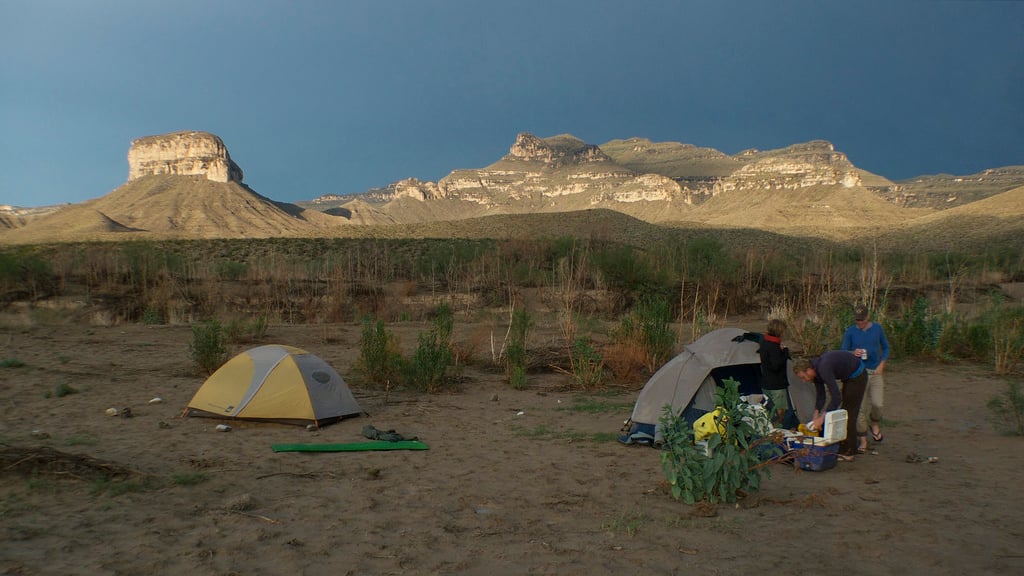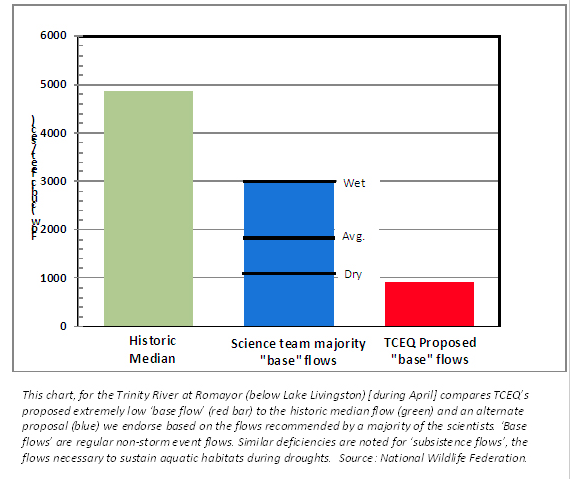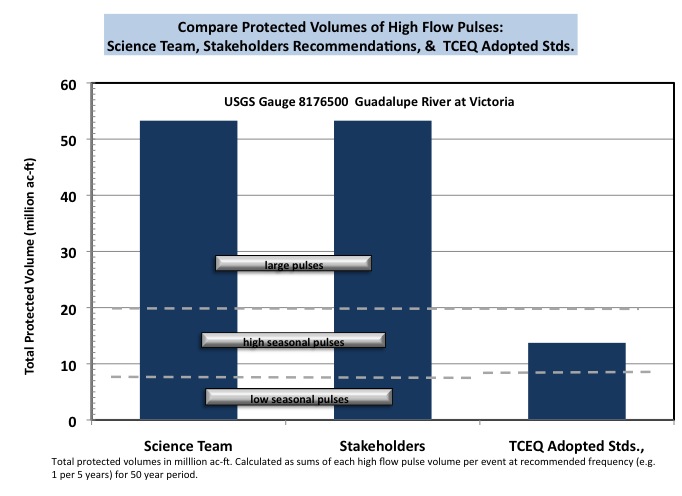A River Runs Through It… For Now
Conservationists were expecting more from Texas' ground-breaking environmental flows process.

A version of this story ran in the October 2012 issue.
[Ed. note: This is a lengthier version of my column that ran in the October issue of the Observer. Thanks for indulging.]
In May, eight friends and I paddled for six days and 82 miles down a remote stretch of the Rio Grande known as the Lower Canyons. Refreshed by the Rio Conchos and generous springs, the river in this section gains momentum and can almost make you forget that for 200 miles between El Paso and Presidio the mighty Rio Bravo is a dry ravine, or that it periodically no longer reaches the Gulf of Mexico at Brownsville. The scenery is harsh and humbling—ancient canyon walls sculpted by unimaginably powerful geological forces rise hundreds of feet above a muddy river strewn with massive boulders that create, in places, not so much whitewater as brownwater.
One soggy night, we camped in Mexico on a rocky alluvial plain above the river while gray bulkheads of clouds throttled the nearby mountains. It poured. We huddled in our tents and waited for the flood. But in the morning the river had come up just a few inches. We paddled on.

By the time we hauled our boats up on the bank at John’s Marina near Dryden six days later, we’d seen just two other groups on the water. It was about as pure a wilderness river trip as one can expect anywhere, much less in Texas. Few have the time, resources, or even the desire to run the Lower Canyons. And I feel privileged to have experienced it.
I relate this tale because the chance to protect Texas rivers, and the coastal bays and estuaries that they nurture, is slipping away. Most rivers in Texas can’t rely on their remoteness to insulate them from exploding population pressures, worsening droughts, and the small-mindedness of certain commercial interests. Increasingly, our rivers are called upon to provide drinking water, receive wastewater, cool power plants, support recreation and breed wildlife, among many other uses. In some river basins there are more water rights allocated than there is water during drought times.
By damming and diverting rivers, we’ve also altered the natural patterns of freshwater inflow into estuaries. That can lead to dangerous increases in salinity and reduced productivity of shrimp, crabs, oysters and gamefish. Rivers were meant to flow into the sea and when they don’t Mother Nature has a way of cruelly correcting us.
Spring freshets, those blessed rainfall events that lead to runoff, not only flush out streams but pump freshwater into estuaries at a critical time in the life-cycle of the species that grow there. They also help salinity-sensitive critters make it through summer. Ironically, in 2007 the Texas Legislature created one of the nation’s most innovative and promising processes for determining how much water is necessary to preserve the ecological health of Texas’ rivers, estuaries and bays. Space doesn’t allow me to explain the details of the process laid out in Senate Bill 3, but it’s a complex blend of science, policy and politics. Environmentalists as well as development-oriented water authorities and suppliers bought in at the outset because both water suppliers and environmentalists wanted some “certainty” about the future, Ken Kramer of the Sierra Club told me.
“Theoretically it makes a hell of a lot of sense to determine what the whole complex needs and not try to do it on an individual project basis,” he said.
For each river basin and its associated estuary and bay system, teams of scientists and stakeholders work to come up with so-called environmental flow standards—basically a water budget that roughly reflects the natural cycles that species have adapted to over millennia.
It’s a tough task. Almost all of our rivers have been dramatically altered from their natural states through pumping, damming and engineering. The goal is to figure out how much water is required for a sound ecological environment and take that into account when considering future water permits. Done property, with concomitant political support and forward-thinking leadership, the process could provide a framework for keeping our rivers flowing decades from now.
The best science suggests that rivers, estuaries and bays—all part of a complex hydrological system—require not just a minimum amount of water but certain flows at certain times in certain quantities.
“You need to have different flows at different times of the year,” said Kramer. “You need variability: Base flows, subsistence flows, pulse flows, over-bank flows.”
Without flow patterns that roughly mimic natural cycles, estuaries and bays can become too salty to support a healthy population of oysters, shrimp, crabs and other species.
In the profoundly-altered Nueces River Delta, one of the most extensive marsh ecosystems on the Texas coast, scientists reported that the effects of curtailing freshwater inflows over just three to six months can “become pronounced and stress effects may become catastrophic.”
The process of drafting environmental flows started in the east, where there’s more water, and has moved progressively westward. The Texas Commission on Environmental Quality, an agency that has become increasingly hostile to environmental concerns over the years, has the final say.
Now, after five years, we have a fairly good handle on how things have shaken out. The good news is that every river/estuary/bay system in the state except one (the Nueces) is currently considered healthy. (Although that’s disputed by some conservationists.)
The bad news is that the Texas Commission on Environmental Quality has taken reasonable recommendations, delicately crafted compromises and mountains of research and basically flushed it all down the toilet. In the case of the Trinity River, which flows through Dallas-Fort Worth to Galveston Bay, the agency adopted standards that the National Wildlife Federation calculated would reduce the Trinity to a trickle during future dry times, potentially jeopardizing the seafood harvest in Galveston Bay.

The TCEQ also low-balled the Guadalupe, San Antonio and Brazos rivers by grossly simplifying and reducing the environmental flow standards recommended by the stakeholder group (standards that were notably less than what the scientists had recommended). For example, on the Guadalupe River the agency dramatically reduced the number and volume of “pulse” events, “floods or times when the river’s full in its banks.”

Jennifer Ellis, senior project coordinator with the National Wildlife Federation, said she thinks TCEQ “reverse-engineered” the environmental flows to accommodate projects anticipated by river authorities. If water were set aside for environmental flows, it may not be available for future water supply projects.
The Guadalupe-Blanco River Authority as well as the Brazos and the Trinity river authorities all have designs on all or significant portions of the water rights not already allocated in their respective basins. That led some of the authorities to make an end-run around the other stakeholders. In both the Trinity and Guadalupe groups, a water authority faction broke off to support less stringent flows.
“Frankly in the case of Trinity some of us were a little too naive in thinking—despite being around for a long while —that everyone in the process would operate in good faith,” Kramer said.
The TCEQ commissioners bowed to the insatiable demands of the river authorities, most of which operate as insular fiefdoms hell-bent on hoarding and selling water to the last drop. To arrive at its woefully inadequate standards, the state agency appears to have ignored the stakeholder recommendations so its reckless growth-at-any-cost paradigm can continue. The agency says it has to balance economic need with environmental protection. But that’s precisely what the teams of stakeholders were charged with doing.
Five years into the environmental flows program, conservationists are wondering if it’s back to the drawing board.
“If TCEQ is just not going to step up to the plate and actually do the job of protecting the river bays and estuaries then it really calls into question whether we can continue to depend on this process,” he said.


